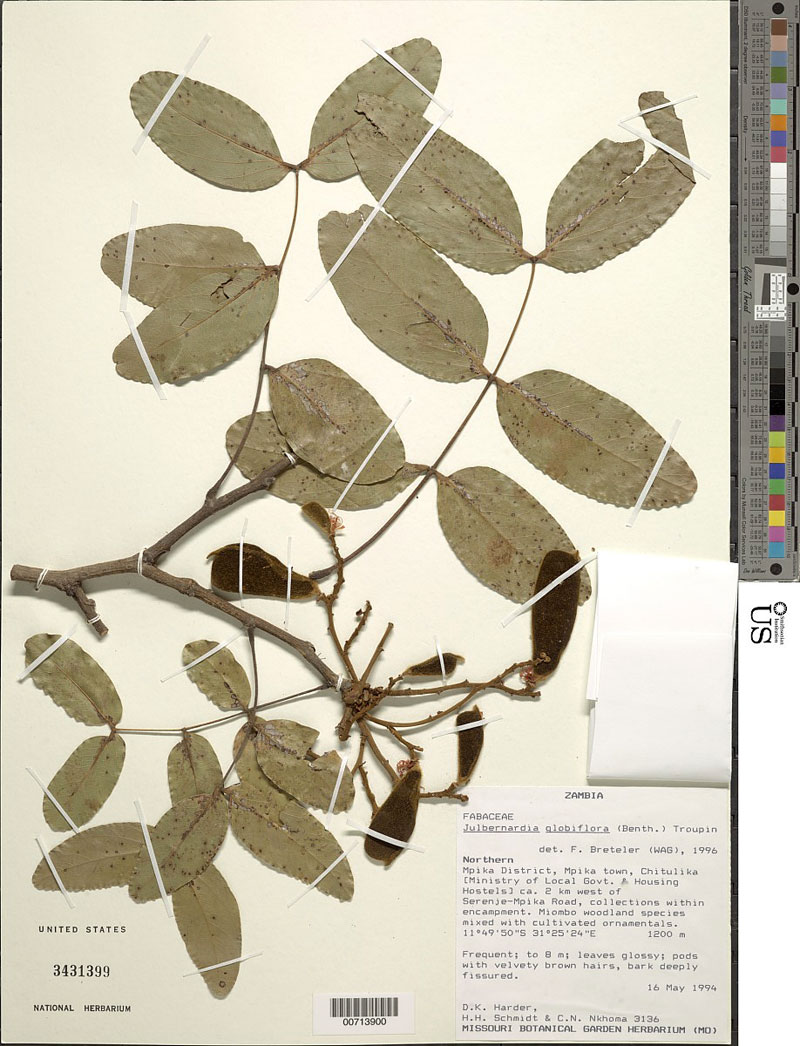
Classification System: APG IV
Superregnum: Eukaryota
Regnum: Plantae
Cladus: Angiosperms
Cladus: Eudicots
Cladus: Core eudicots
Cladus: Rosids
Cladus: Eurosids I
Ordo: Fabales
Familia: Fabaceae
Subfamilia: Detarioideae
Tribus: Amherstieae
Genus: Julbernardia
Species: Julbernardia globiflora
Name
Julbernardia globiflora (Benth.) Troupin, 1950
Synonyms
Berlinia eminii Taub.
Berlinia globiflora (Benth.) Harms ex Engl.
Brachystegia globiflora Benth.
Isoberlinia globiflora (Benth.) Hutch.
Pseudoberlinia globiflora (Benth.) P.A.Duvign.
Westia eminii (Taub.) J.F.Macbr.
Distribution
Native distribution areas:
Continental: Africa
Regional: Tropical Africa
Angola, Botswana, Burundi, Malawi, Mozambique, Namibia, Tanzania, Zambia, Zaïre, Zimbabwe
References: Brummitt, R.K. 2001. TDWG – World Geographical Scheme for Recording Plant Distributions, 2nd Edition
References
Primary references
Troupin, G.M.D.J., 1950. Bulletin du Jardin Botanique de l'État à Bruxelles 20:314.
Links
Govaerts, R. et al. 2020. Julbernardia globiflora in Kew Science Plants of the World online. The Board of Trustees of the Royal Botanic Gardens, Kew. Published online. Accessed: 2020 Sep 11. Reference page.
International Plant Names Index. 2020. Julbernardia globiflora. Published online. Accessed: Sep 11 2020.
Tropicos.org 2020. Julbernardia globiflora. Missouri Botanical Garden. Published online. Accessed: 11 Sep 2020.
Catalogue of Life: 2021 Annual Checklist
USDA, ARS, Germplasm Resources Information Network. Julbernardia globiflora in the Germplasm Resources Information Network (GRIN), U.S. Department of Agriculture Agricultural Research Service. Accessed: 07-Oct-06.
Vernacular names
Afrikaans: Dubbelkroonboom
Julbernardia globiflora is a tropical African tree widespread at moderate altitudes in Miombo woodland to the south and east of the equatorial forest region of the Congo basin. Its common name is mnondo. It is ecologically important over wide areas and is dominant to co-dominant in many types of woodland, always being most successful in drier types of deciduous woodland where there is less competition.
Contents
1 Distribution
2 Ecology
3 References
4 External links
Distribution
The mnondo occurs away from the coast except at the southern limit of its range. It prefers a hot dry resting season and plenty of rain in the summer growing season. It grows best where there is a definite contrast between day and night temperatures and does best at altitudes of 1,000 metres or more (the inland plateaus of south tropical Africa.) From Tanzania across to Angola it is found in dry types of woodland and is seldom dominant although common in many woodland types. It is the only species of Julbernardia present in Botswana (the northern parts only) and it reaches its southern extent in Mozambique just south of the Save River near the coast at about 22°S, not reaching outside the tropics.
In Zimbabwe it is common in all types of deciduous woodland and is often co-dominant with the msasa and is also locally common in the drier woodland of the south where the msasa does not thrive.
Ecology
flowers and foliage
The mnondo is a medium-sized tree, but larger towards the north of its range. In the northern half of its range, it is generally 15–16 meters tall but can grow up to 18 meters. There it is deciduous but may not lose all of its leaves before producing new ones. In the southern half, it is usually smaller (12–13 meters is a large specimen). There it is also deciduous but sometimes stands bare for two months or more. During spring it displays a bright red foliage, and in Zambia, Zimbabwe and Malawi it joins the Msasa's springtime leaf show in late August. It is not as variable in its leaf colours as the msasa and the red colour fades back to green more quickly.
The mnondo closely resembles the msasa in many ways and the two are not easy to tell apart, especially in the southern parts of the mnondo's range where they are much closer in size. The distinguishing feature is that the leaflets on the msasa increase in size towards the end of the leaf, making them hang downwards, while those of the mnondo are biggest in the middle so they do not hang in the same way. Secondly, the mnondo blooms later than the msasa, in mid-summer (around January). Although the flowers are just as insignificant as those of the msasa, the mnondo pods are concentrated at the top and sides of the tree and are readily visible in late summer, unlike the msasa's that are among the leaves. The mnondo also has a less impressive shape and lighter branches so it is less attractive in appearance.
References
Coates Palgrave, K. (1997) Trees of Southern Africa, Struik Publishers
Sikho Megi, Miombo woodlands of Southern Africa
Retrieved from "http://en.wikipedia.org/"
All text is available under the terms of the GNU Free Documentation License

